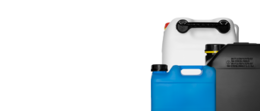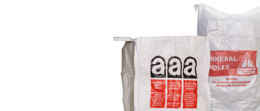Material Information
PET (polyethylene terephthalate)
is a versatile, lightweight and shatterproof plastic that is mainly used as a packaging material and can be recycled and reused after use. Polyethylene terephthalate (PET) is used in many areas of industry. Its good mechanical properties, transparency and high resistance to chemicals and weathering make PET a popular material.
PET quality classes:
In the industry, Polyethylene Terephthalate (PET) is classified into two primary quality categories based on their distinct physical properties: amorphous (non-crystalline) PET and semi-crystalline PET.
- Amorphous (non-crystalline) PET is characterized by a disordered molecular structure that is not crystalline. This form of PET is mainly used for the production of films and fibers, as it has a higher transparency and flexibility. Amorphous PET is easy to process and is used in the packaging, textile and electronics industries.
- Semi-crystalline PET has a partially ordered molecular structure, which gives it greater strength and rigidity. These properties make it particularly suitable for the production of bottles, containers and other rigid packaging. Semi-crystalline PET also has better resistance to chemicals, moisture and gas permeability and is therefore often used in the food, beverage and pharmaceutical industries.
Overall, the PET quality classes are tailored to the different requirements of the various branches of industry. Amorphous PET is preferred for films and fibers due to its transparency, flexibility and ease of processing, while semi-crystalline PET is used for bottles and rigid packaging due to its strength, rigidity and improved resistance properties.
Production of PET:
PET is produced by a condensation reaction in which ethylene glycol and terephthalic acid react with each other. The reaction takes place at a temperature of around 280 to 300 degrees Celsius. The polymerization produces a long-chain polymer that is available in the form of pellets or granules. These can then be further processed, for example into bottles or films.
Areas of application:
PET (polyethylene terephthalate) is a versatile polymer that is used in various industries due to its excellent properties such as lightness, strength and transparency. Here are some applications of PET in the industries listed:
- Paints and coatings: PET is used in the paint and coatings industry as a packaging material for paints, varnishes, resins and other chemical products. Due to its chemical resistance and its ability to withstand light and moisture, PET is a good choice for packaging these materials.
- Chemical products: In the chemical industry, PET is mainly used for packaging chemicals, detergents and other chemical products. It is resistant to a wide range of chemicals and is therefore well suited for these applications.
- Food and beverages: PET is one of the most commonly used packaging materials for food and beverages. It is used for bottles, containers, trays and other packaging to preserve freshness, taste and quality.
- Building materials, production and trade: In the construction industry, PET composites are used as a substitute for traditional materials such as wood, glass or metal. PET can be used in the form of sheets, insulating materials, coatings or as reinforcement in composite materials.
- Disposal/recycling: PET is a widely used material in the recycling industry as it can be easily recycled and processed into new products. Recycled PET (rPET) is used to make fibers, bottles, containers, films and other products, helping to reduce the environmental footprint.
- Mineral oil + lubricants: PET packaging is also used in the mineral oil and lubricants industry. PET containers and bottles are used for the storage and transportation of oils, greases and lubricants because they are chemical-resistant and lightweight.
- Plastics and rubber processing: In the plastics and rubber processing industry, PET is used both as a raw material and in the form of recycled fibers. PET is processed into films, sheets, fibers and molded parts. rPET can also be used in composites and blends with other plastics or rubbers to improve material properties.
- Cosmetic products: In the cosmetics industry, PET is used as a packaging material for a variety of products such as creams, lotions, gels, serums and liquids. PET bottles, tubes and containers provide lightweight, unbreakable and attractive packaging that also ensures the shelf life and stability of cosmetic products.
In summary, PET (polyethylene terephthalate) is a versatile and widely used polymer in a variety of industries. Its excellent properties such as lightness, durability, clarity and recyclability make it a preferred material for packaging, construction materials and many other applications. PET has many advantages due to its good mechanical properties and high resistance to chemicals and weathering. It is a lightweight and robust plastic that is easy to process.








